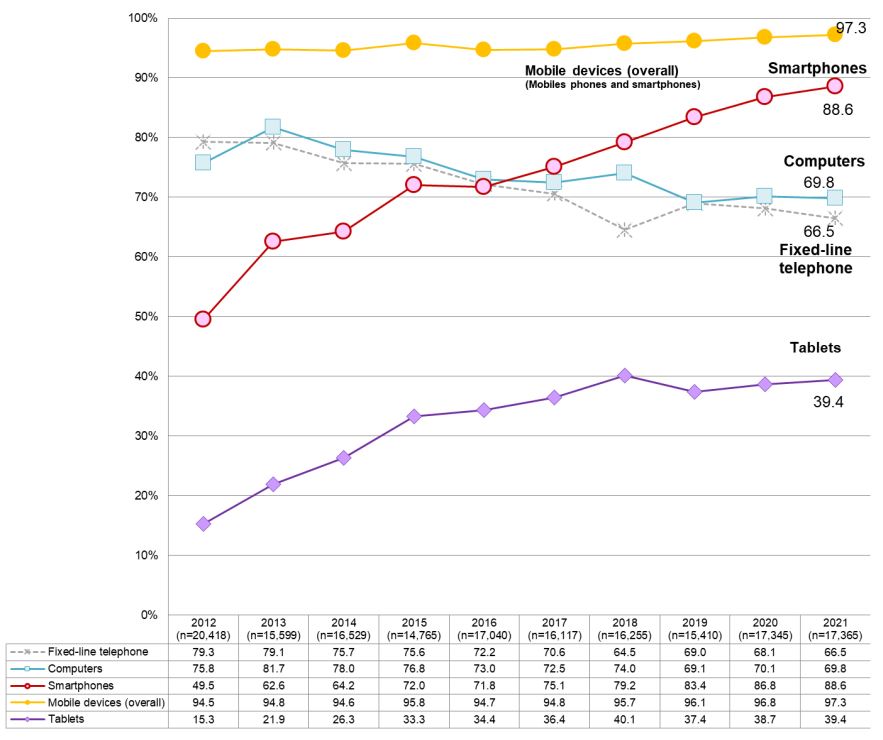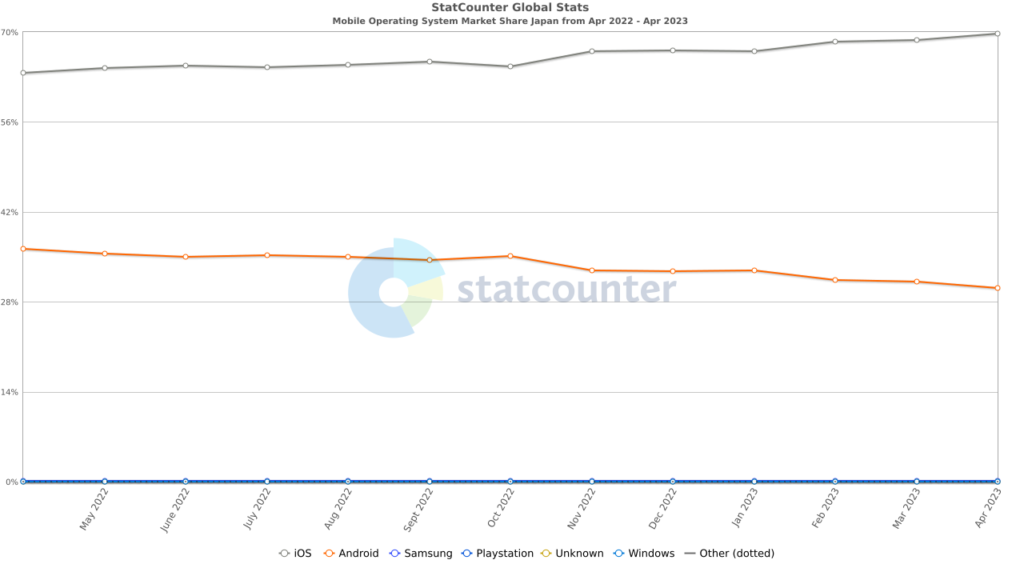With this content, you can understand the various marketing platforms and each demographic for Digital Marketing in Japan.
The Japanese market is highly unique.
This is a phrase you have probably heard many times when looking for digital marketing in Japan. Some international companies have tried and failed to enter this “very unique” market. Examples include Ford’s failure to compete in Japan, with the comment “It’s a closed market” and Forever 21’s exit from the Japanese market in 2019. Walmart was failing to gain traction against other Japanese competitors in 2008. Therefore Walmart intended to list Seiyu, one of the biggest Japanese supermarket chains acquired wholly by Walmart in 2008.
Many international businesses have successfully entered the Japanese market despite the difficulties.
Success Stories of Digital Marketing in Japan
McDonald’s opened its first restaurant in Japan in 1971, and now has restaurants all over the country. Starbucks too– you can find Starbucks coffee everywhere. But that’s just the tip of the iceberg. Many international financial giants are based in Japan, including Goldman Sachs, UBS, JPMorgan, Wells Fargo, Citi, Deutsche Bank, Morgan Stanley, and Bank of America Merrill Lynch.

Technology companies have succeeded too. Apple products are incredibly popular. Statistics show that over 60% of smartphones used in Japan are iPhones. Additionally, digital nomads all over the country use their MacBooks in coffee shops when they work remotely. Amazon is another success story. Amazon is growing fast. It competes directly with Rakuten, Japan’s e-commerce retail tech giant. Other tech success stories include Google, the No. 1 search engine in Japan, and surprisingly, Slack too. It was quite popular in the Japanese tech community even before they started localizing. Despite struggling to enter the Japanese market due to taxi industry regulations, Uber Eats has gained traction. You can see bicyclists with Uber Eats bags zipping around almost 24 hours a day.
There are certain points you need to know to dominate this 6.5 trillion-dollar market. If you consider these points, it is possible to acquire customers and produce great results for your business. Here, we will present the Japanese web landscape. We base this post on statistics and industry experiences of our digital marketing agency in Japan. The goal is for you to better understand the Japanese market when planning your digital marketing strategy in Japan.
Technology Environment for Digital Marketing in Japan
Which devices are used in Japan?
As mentioned, the iPhone is incredibly popular in Japan. The tech environment that users use to access your website or app can affect how they see it. Factors like the device, operating system, browser, and internet speed can all play a role. By understanding who your users are and what technology they use, you can make better decisions about your digital marketing and design strategy.
A recent survey published by the Ministry of Internal Affairs and Communications on tech devices shows that around 88% of Japanese households have a smartphone. That is greater than laptops, which 69% of Japanese people own. In the study, 40,000+ households were asked about their device and internet usage.
In this chart above, the Yellow line shows all mobile devices, including smartphones and flip phones (yes, they still exist!). It is also visible that the usage of landlines and computers are decreasing while smartphones and tablet are increasing since 2012.
Though more and more people have mobile devices, people use desktop computers too. Statcounter, a website that displays various kinds of technology environments worldwide, shows that desktop users are more common in Japan, as shown below.
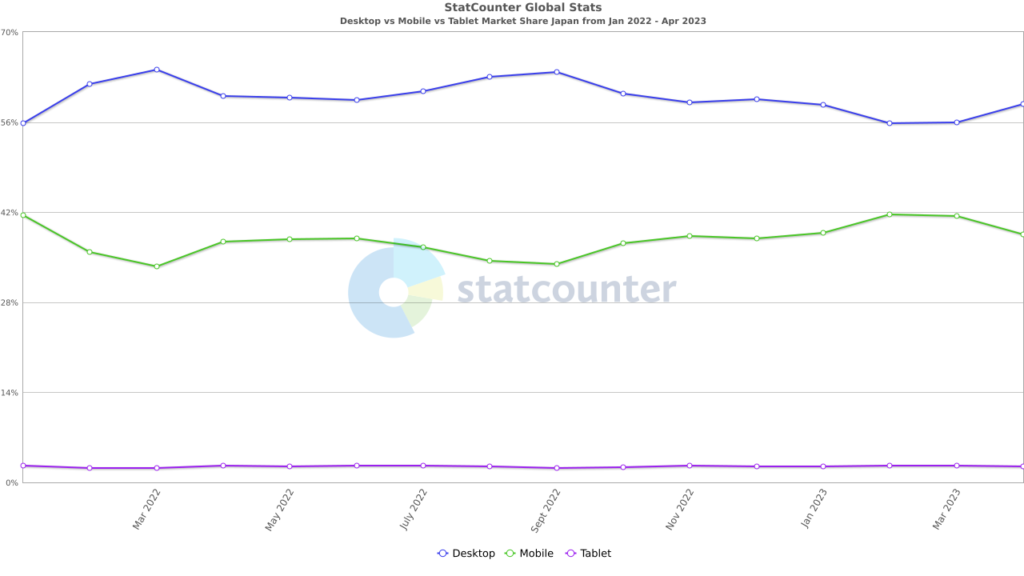
Source: Statcounter
What are the operating systems used in Japan?
Are most of the mobile users in Japan Android or iOS users? If your business owns a mobile native app, this is especially important – because the app development process is different depending upon the operating system. You might want to start with an iOS app or an Android app first to test the Japanese market, not develop both at the same time. Developing two apps takes more time and you don’t want to spend too much before test marketing. If so, which app should you develop first? Well, generally speaking, iOS is recommended.
NTT Docomo, one of the largest mobile network operators in Japan (imagine the Japanese version of AT&T), released a white paper on mobile phone usage in 2022. They asked 7,000 users how they use their mobile devices and what devices they use. They found that 53% of respondents used Android devices, while 47% used iPhones.
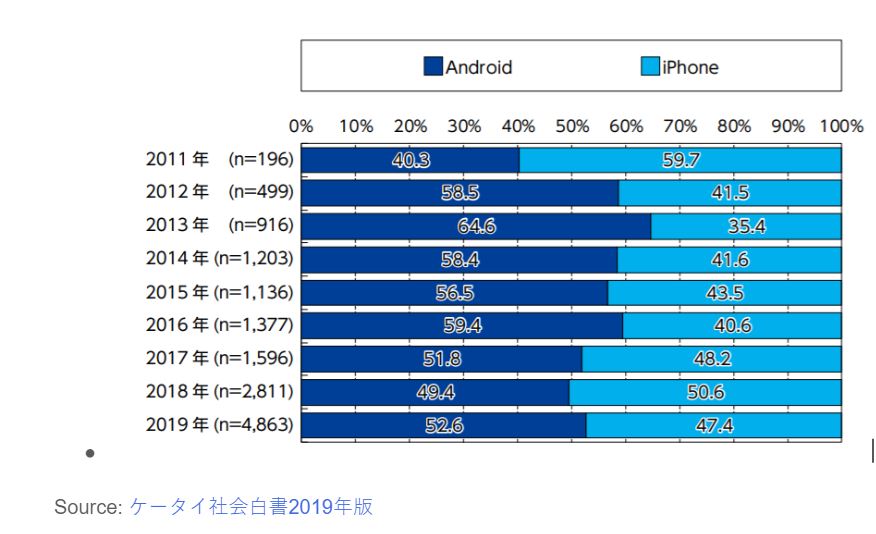
Another stat we should consider is on Statcounter the mobile OS market share in Japan. As you can see below, iOS has always been more than 65%, whereas Android was around 30 – 40% in 2022. The usage of Android is even slightly declining since the end of 2022.
We here at Tokyomarketing have been analyzing different kinds of websites with Google Analytics. We have never seen a case where there were more Android users than iOS users. Usually, more than 60% of mobile traffic is from iOS users and less than 40% is from Android users. Because the data provided by NTT and Statcounter say “it’s almost half” or “iOS is far greater”, and because we have seen websites with more than 60% iOS users, we generally recommend iOS first on mobile to be safe.
Which browser is most used in Japan?
As a web developer or web marketer, you want to make sure that your website won’t look buggy – but it happens sometimes, depending on the browser. Is there anything we should consider when choosing a browser?
Chrome and Safari are the most popular browsers in Japan. However, Microsoft Edge, Opera, Samsung Internet, and Firefox are also quite popular. Another stat from Statcounter shows that Chrome and Safari are the most popular browsers in Japan – you can see Firefox, Opera, and Samsung Internet trail far behind.
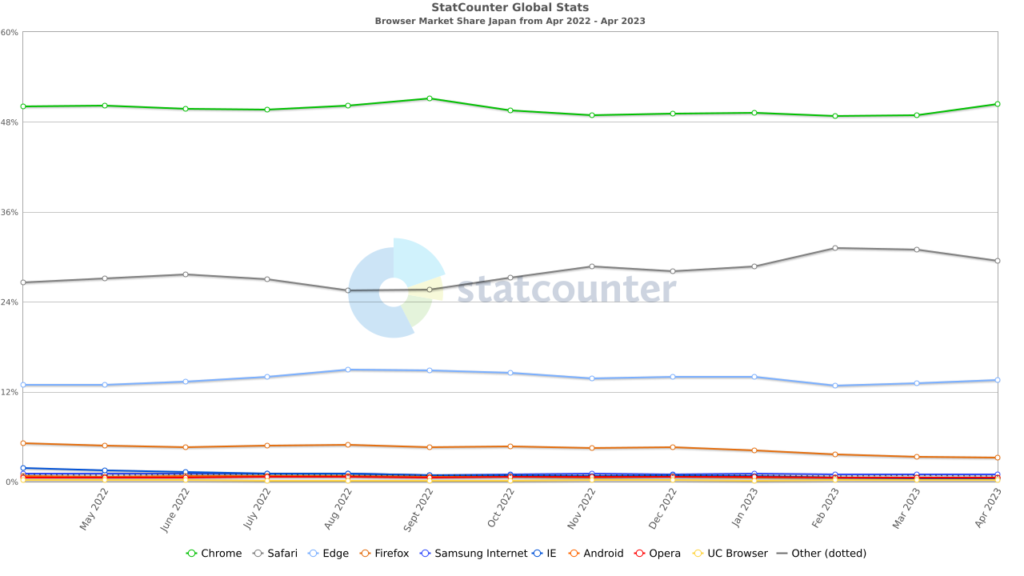
Since Microsoft ended its support of Internet Explorer the usage is declining in Japan significantly. Users seem to have switched to Microsoft Edge and/or Chrome. In conclusion, you should optimize your website for Chrome and Microsoft Edge, as usually, it will look also fine on Firefox and Safari.
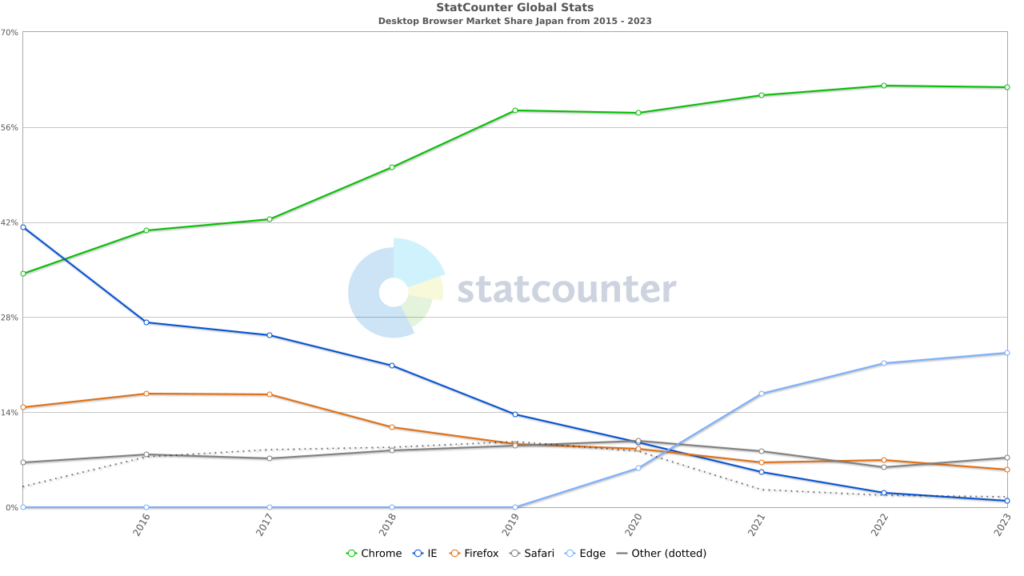
Japan's Internet Speed: How Fast Is It?

Speed improvement sounds like a simple thing, but it is not easy to measure the exact improvement. Speed differs based on many factors such as user location, device, bandwidth, etc. Of course, you should try to improve the speed of your website or app generally, but knowing the general internet speed in Japan can help you decide how much you should worry about this.
According to the Global Index published by Ookla, the global average connection speed for download is 80 Mbps and 35 Mbps for upload for fixed broadband. Japan ranked here 15th overall, with 150 Mbps Download and 94 Mbps Upload connection speed. This is slower than in some countries such as Singapore, Hong Kong, and China, but faster than in Canada and Hungary. This means that internet speed in Japan is generally not slow and is faster than many other countries, but not amazingly fast. This is important to know.
The Importance of Local SEO in Japan
A Beginner's Guide to Search Engines in Japan
Depending on your business and target audience, search engines can be a great source for customer acquisition. There are actions and strategies you can consider for Search Engine Optimization, or short SEO, such as creating and maintaining content, getting backlinks from authoritative websites, removing broken links to maintain internal links, etc. The basics of SEO are the same regardless of where you are – “Content Is King”. However, there are certain points you can take into consideration for digital marketing strategies in Japan.
How Does the Japanese Search Engine Market Compare to the International Market?
In short, Google dominates the Japanese search engine market, but one unique thing here is that Yahoo! Japan is still relatively more popular. Yahoo! may no longer be popular worldwide, since it has kept losing market share to Google and so was acquired by Verizon in 2017. But that is not the end of the story. Below, you can see that Google covers 93% of the search engine market share – 3% for Bing, and 1.1% for Yahoo globally in 2023.
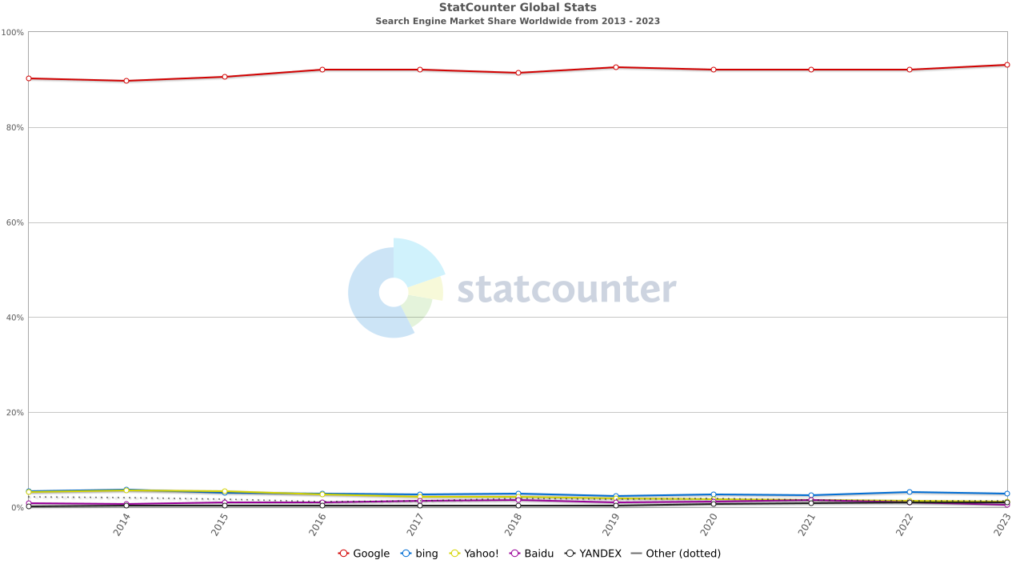
However, compare that to Japan in 2023. You can see that Yahoo! Japan still controls 14% of the market though Google still controls 77%. Therefore, if you take that into account and optimize your website for Google and Yahoo, you should be able to cover more than 90% of searches in Japan.
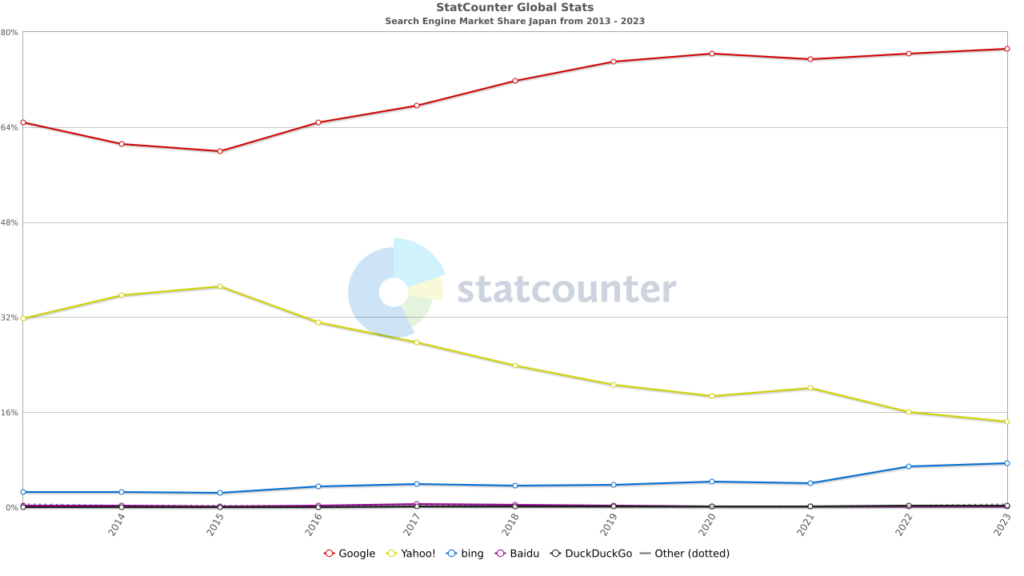
So the question is, what do we need to do to optimize websites specifically for Yahoo! Japan, not only for Google? In short, don’t worry and just focus on Google. Yahoo! Japan and Google are in partnership. Yahoo! Japan has been utilizing Google’s search engine algorithm since 2010, so most search results are the same. The only exception is for some Yahoo-related services such as Yahoo! Shopping (just like you see Google Shopping in Google). So generally, if you get the 1st rank in Google, you should get the same on Yahoo! Japan too. Also, Yahoo! Japan doesn’t have tools like Search Console, so you cannot submit a sitemap – you don’t have to do anything for Yahoo! Japan.
However, if it’s search ads, we recommend running a test on both Google and Yahoo!. This is because you may have a chance to acquire conversions more cheaply in Yahoo!, depending on your industry.
How to Do Keyword Research for Your Japanese Website
The basics of keyword research and content marketing are not so different between English and Japanese – the most highly recommended tool is Google’s Keyword Planner here in Japan too. You need to check keyword and phrase volumes to identify how people are searching in Google. Afterward, you need to publish content targeting the keywords or phrases you choose.
However, in practice, we recommend asking a Digital Marketing Agency with Japanese professional SEO Marketers to research keywords. How people search slightly differs depending on their language and culture.
For example, when you are looking for the best Izakaya (Japanese dining bar) in Tokyo, you may search for:
- “Best Izakaya in Tokyo”
- “Highly Rated Izakaya in Tokyo”
- “Affordable Izakaya in Tokyo”
Whereas Japanese users would search:
- “居酒屋 東京 (Izakaya Tokyo)”
- “居酒屋 人気’(Izakaya popular)”
- “居酒屋 安い (Izakaya cheap)”
There are two points to note here.
- Groupings of keywords or phrases. In English, users are more likely to search with phrases, not a group of two or three keywords. In Japanese, users are more likely to search with a group of two or three keywords.
- Connotations. In English, “cheap” has a slightly negative meaning that implies “low quality and bad” whereas “affordable” does not. In Japanese, “安い(cheap) doesn’t have a connotation of “low quality and bad”, so people don’t mind searching for a place with the phrase “Izakaya cheap”. Unprofessional or non-Japanese SEO Marketers may use “お得” or “手頃” as the term for “affordable” since it’s the direct translation of “affordable”, but both of them have almost no search volume – so you will earn almost no traffic. This is the same for “highly rated” because, if it was translated directly, it might be “高評価(highly rated)”, but Japanese users don’t use that term. Instead, they use “人気 ‘(popular)”, because Japanese people have the notion that popular places should be highly rated places, and “人気” requires slightly less typing than “高評価” so it’s also just easier to type into Google.
It is easy for Japanese SEO Marketers to identify keywords by taking those points into account. However, it may not be as easy for non-Japanese SEO Marketers, because these points require a sense of Japanese wording and phrases, in addition to knowledge of Japanese culture which could require years of living in Japan.
Social Media Marketing in Japan: The Top Platforms for Reaching Your Target Audience
The social network landscape is somewhat similar and somewhat different. Globally popular social network sites, such as Facebook, Instagram, and Twitter, are popular in Japan too. On the other hand, LINE, a Japanese app similar to WhatsApp, is much more popular across Japan than other social network apps or websites. Below is research from Gaiax, a tech company focusing on social network management, on social network usage in 2023.
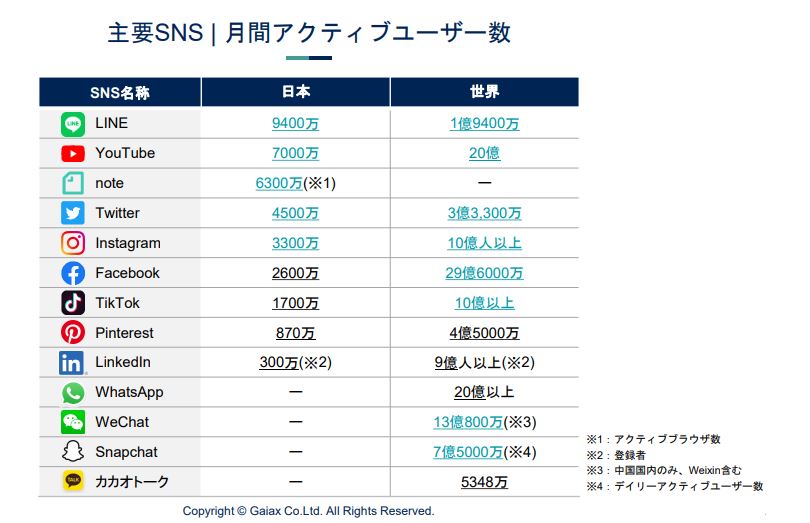
Source: Social Media Lab by Gaiax
Given that around 125 million people live in Japan, around 75% of Japanese people are active on Line – far more than any other social network site. Twitter has the second-largest user base in Japan. It is the most popular non-Japanese social platform. Regarding the other big American apps: Instagram is getting more and more popular among young people, but Facebook seems to be on the decline.
If you want to try advertisements on these platforms, it is recommended to identify what website you should target based on your industry and test. Keep monitoring performance indicators like Cost Per Acquisition and/or Return On Investment. Then compare this by platforms, so you can find the best way to acquire customers. The user base can be a good indicator in terms of understanding the number of potential customers, but ultimately you need to figure out which one works the best for you by testing continuously.
The chart below is showing the user base by age group. LINE is popular in all age groups (above 90 %). Twitter and Instagram are most used by the younger generation between 10 and 30 years old and slowly decrease in popularity. However, Facebook is more used by the older generations starting from 30+ years.
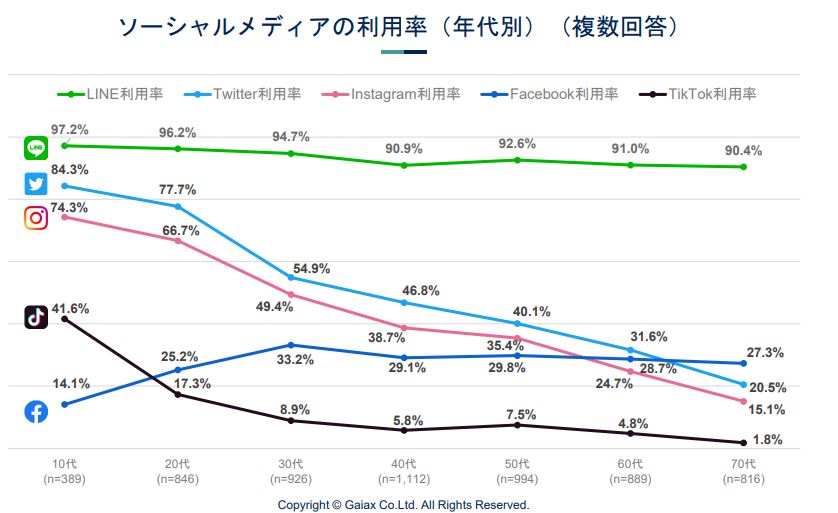
The Key to Success for Digital Marketing in Japan
While there are certain points about the Japanese digital landscape which are quite different, it is also similar to the global trends. With a basic understanding of digital marketing and knowledge of those unique points, it is certainly doable to run a campaign, acquire customers and dominate this market, as other global tech companies have done.
